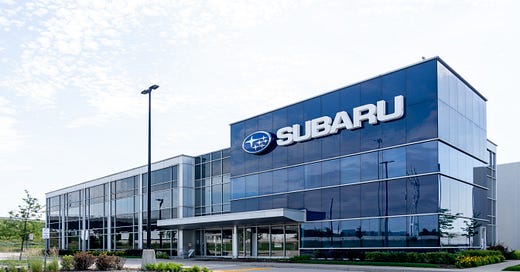The Great Car Switcheroo of 2022, Part 1
The impact of the chip shortage on the market for cars
In the fall of 2022, my son totaled his car in a three-car pileup.
It was the second car we’d given him. The first one died, and we were running out of cars.
The accident happened on his way to work on the top end of I-285 (Atlanta), where a huge road construction project was in progress. The project connected I-285 to SR400. Don’t let the state road designation fool you. It’s a multi-lane road that goes northbound from I-85 northbound just south of Lenox Mall in Atlanta to SR 20, just south of Dahlanega, GA.
Both roads were already a mess before the construction started. The goal was to make access to I-285 from I-400 easier—and it is. Now.
During the construction my son was commuting from his home in Tucker to work near I-75. Residents and commuters on the northern side of Atlanta can tell you what was already messy became a slow-moving parking lot.
If it moved.
I-285 is an accident-prone highway, rated the deadliest in the US in 2013 by the National Transportation and Safety Board (NTSB). Many accidents occurred in the area during construction. My son was in one of them.
So, he needed yet another new car. It was the last one we had. (Such nice parents…) We went from a two-car household to one car after the move away from the city. That was a good thing because our new home didn’t have a garage, an oddity in metro Atlanta. My son and his wife also had a one-year baby, and my daughter-in-law needed a car to get to work and take the baby to daycare.
It was also a good thing because new and used cars became impossible to find and got more expensive. According to moneygeek.com, using information from the Kelley Blue Book, the average price of a non-luxury sedan increased 30 percent from 2018 to 2023, while the prices for full-size pick-up trucks increased by 27 percent.
From late-2020 until mid-2022, part of the problem was a chip shortage.
Almost everything electronic in your home uses one or more semiconductors (chips) to relay commands from the buttons you push to the mechanics. All newer cars use thousands of chips for everything from starting the engine to running diagnostics to rolling the windows up and down.
When they’re not available, that’s a problem.
When car sales lots are empty, because of the shortage, that’s a very big problem.
The car manufacturing industry was hit especially hard. Poor planning at the beginning of the pandemic caused car manufacturers to cancel chip orders already in place, which led to lost production of about 7.7 million cars. Lost production cost the car companies and the nation about $210 billion in lost revenue and GDP (gross domestic product).
Without new cars to buy, consumers switched to used cars. According to cnbc.com, even with the markups in price, soon those were gone too. If you wanted a new car in 2021 or 2022, your choices were limited and expensive.
You can see my son’s dilemma.
Why did this happen?
In a report from J.P. Morgan, as a result of the pandemic and other factors, demand for goods that used chips rose, as the demand for new computers and peripherals rose. At the same time the supply of those semiconductors fell. The shutdowns in China and Malaysia caused production and packaging to cease.
Demand rose as remote work became necessary and technology became better suited for work at home. My husband worked as a software engineer at the time. He told me that switching to remote work wasn’t easy. The process required upgrading home equipment and improving at-home internet security to protect the company’s proprietary technology.
Sales and marketing staff had laptops. But in software engineering, laptops are a poor option. Most software engineers have desktop computers with upgraded security and two wide-screen monitors. Some had to update their home computers. Other remote workers, including freelance workers and those new to remote work, bought laptops and new computers.
As a result, there was a spike in demand for computers, phones, and computer accessories. Upgrades to existing home equipment were popular.
Competing demand for chips used in computers and peripherals exacerbated the problem for car manufacturing. The need for more (and better) work-from-home technology caused a reallocation of chips to home office products.
Within the auto industry, demand for electric vehicles (EVs), which rely even more on chip technology, was growing which also increased the overall demand for chips. According to the Bureau of Labor Statistics (BLS), in 2011 the share of motor vehicles that were electric was .01 percent. By 2021, that share was 4.6 percent. The BLS estimates that 40 percent of all car sales will be EVs by 2030. One EV uses an average of 3,500 chips, compared to 1,400-1,500 for gasoline-powered cars.
One other source of increased demand was bitcoin mining. We’ll look at that in part 2. We’ll also look at the supply side of the story and the resolution. See you tomorrow!
As always thanks for reading. Comments are welcome.
Nikki





My fiancé and I made one of the smartest financial decisions of our lives during the pandemic: buying a new car. We hit that sweet spot where everything was going for incredibly cheap because the dealerships were stuck with so much inventory and very little demand for new vehicles.
Thank you Ann!